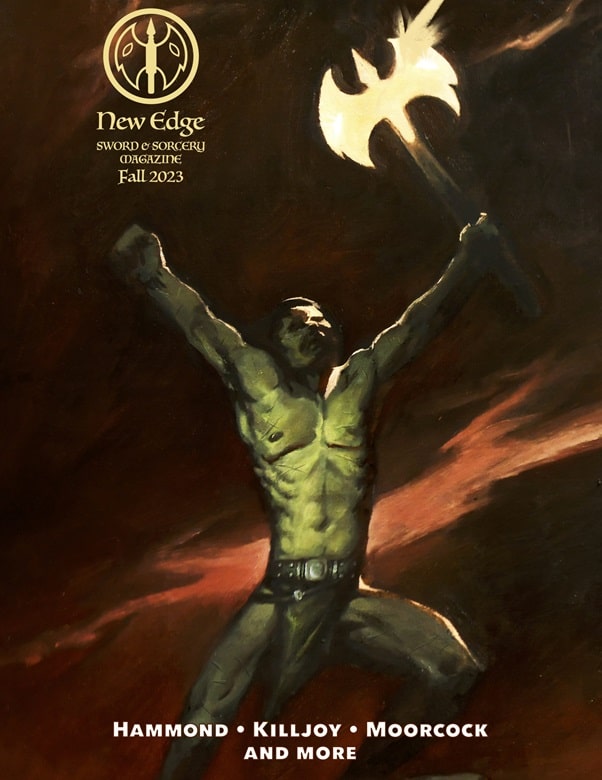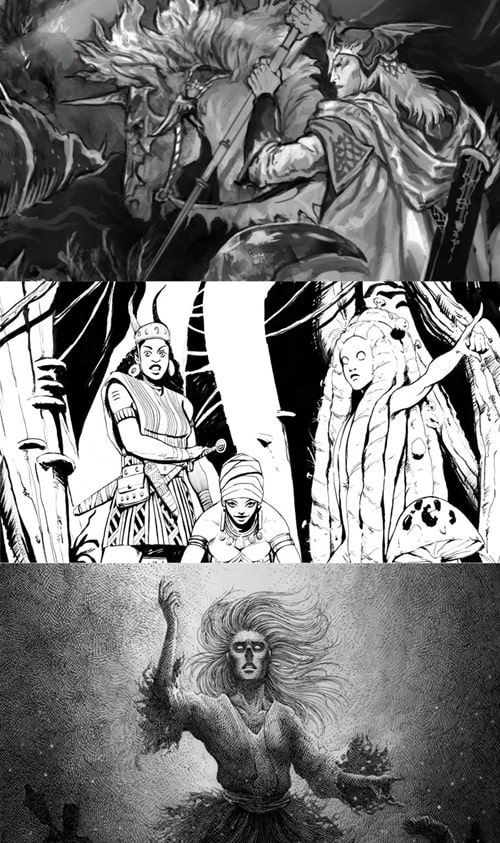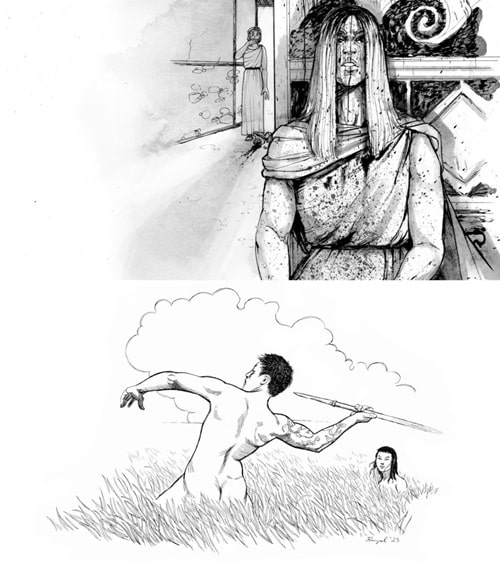Bringing a Whetstone to an Old Blade: New Edge Sword & Sorcery Magazine #1
New Edge Sword & Sorcery Magazine, Fall 2023. Cover by Caterina Gerbasi
Disclosure: I was a Backer for the first four issues of this new journal.
As with the Zero issue, New Edge has absolutely fantastic, journal-level production values: heavy paper stock, trade or hard-cover binding, 8.5 x 11 stock, clean, professional layout, and absolutely terrific artwork. It looks great, feels great in the hand and has nothing amateurish about it. Whereas a counterpart magazine, Tales From the Magician’s Skull, has similar production quality but leans into a 30s pulp-retro vibe intentionally, NESS has a much more contemporary vibe, which fits its idea of taking a venerable genre and recasting it for modern audiences. (Which it does to varying degrees of success.)
So, looks great. How’s the contents?
Good, and the good pieces are very good. The less so miss more for reasons, IMO, of editorial choices that seem to build off the goals found in the Zero issue and may just be the magazine finding its footing.
As in the zero issue, #1 is divided between short stories in the first half and then journal articles, by a variety of authors chosen for their ability, but also to represent racial, ethnic and gender diversity, a driving interest of editor Oliver Brackenbury and a part of how he interprets the term “New Edge” (which I note here, as it is actually slightly different than what was originally meant when coined by Howard Andrew Jones). Consequently, we have a mix of Black, east Indian, White, male, female and (as I recall) a non-binary writer, along with fantasy legend Michael Moorcock, who I guess is the quintessential Old Straight White Guy who dominated the genre’s first two iterations.
Fortunately, the casting for different voices pays off.
Kirk A. Johnson is a newer voice in Sword & Soul (African Fantasy), and published a recent collection called The Obanaax. Johnson’s prose still needs refining at times, and it shows here, which makes his story as the kick-off a bit rough, but the finale of “Carnivora” is haunting and the visuals stayed with me throughout the issue.
Interior artwork from New Edge Sword
& Sorcery Magazine, Fall 2023 issue
“Come Lay the Crone to Rest” by Margaret Killjoy is a beautifully written story that is sort of representative of Tanith Lee’s contributions to S&S. It is in some ways the most traditionally “European” story in the magazine, though it is certainly doing its own thing. I don’t think I’m short-changing Ms. Killjoy in saying this isn’t a Lee-level story, but it’s darn good.
“Sister Chaos” by Bryn Hammond is the second time the author has appeared in New Edge and I’m torn on what to say. Here I’ll leave it at the idea of one can appreciate an artist’s craft, but not enjoy the work. In this case, I think Hammond is a great writer but misplaced in a sword & sorcery magazine; but I’m not the editor. Consequently, one may or may not enjoy this Asian fantasy and decide it fits perfectly what they want.
As a student of Mesoamerican and South American civilizations, who also works those realms into his fantasy, I was really excited to see “Chak Muuch” by Jesús Montalvo, translated from Spanish by Gonzalo Baeza. The prose has some rough translation spots, and this is a good reminder that, although the author is Mexican, that does not convey an automatic knowledge of the Maya world: there are some misused Yucatec Maya words and references to bananas, which were introduced by the Portuguese and didn’t make its way up into the Yucatan until the 17th century. But I’m picking nits (the banana thing makes me nuts, and this was the third story in the time/place I’ve read in the last few months that makes this mistake); the story is decidedly original and the end is wonderfully creepy. The style, somewhere between a traditional folklore tale and modern sword & sorcery, definitely has a Latin American vibe we don’t get in a lot of Anglophone lit and makes a nice addition. Next time, I just hope the editors will work to smooth the translation a bit more.
“Tears of Eb” by Sarah A. Macklin is by far the star of the magazine for me. This story has it all: a strong heroine we want to see more of, whom as a swordswoman, makes sense in her historical setting, with just enough backstory to make her interesting without derailing the story; a strong sense of world and setting; some very creepy supernatural beings that are perhaps an African equivalent to unseelie faeries; and great action scenes. Macklin can write, she can world-build, and I want more of the duo she creates in this story.
“The Pillars Of Silence” by Prashanth Srivatsa is a story I wanted to love but couldn’t quite manage. India is soooo perfect for sword & sorcery, but in the end this is a not-so-original take on an old trope: a village engaged in a lottery to feed a monster; and unlike “Tears of Eb,” the heroine is unconvincing. I didn’t find her voice distinct, or even very feminine, nor, considering how rigid India was in terms of caste and gender roles, any understanding of how a swordswoman was wandering about as an agent handling these problems. The story felt like a draft that didn’t quit pull together.
“The Folk Of The Forest” by Michael Moorcock is a tale of young Elric, and not a grim and dour one, so if you wanted another moody story of the Doomed Emperor, sorry. Instead it is a youthful adventure that tells us more about Prince Elric and his relationship with his mentor Tanglebones. It’s not a big story, it is a delightful one, and I think it’s perfect for the magazine.
The essay section is more of a mixed bag, unfortunately, building on a problem I noticed in the zero issue.
“Why (New Edge) Sword & Sorcery?” by Brian Murphy, is a sharp, concise essay, with fun, whimsical illustrations by no less than Sara Frazetta. There are few people more appropriate to launch the magazine with this essay (besides Howard Andrew Jones, who coined the term), and Murphy explains his rationale well.
“Cele Goldsmith Lalli — Midwife to the Second Sword & Sorcery Boom” by Cora Buhlert, is a delight. Buhlert isn’t just a great writer, she’s a great proponent of drawing our attention to the women who have always been a part of this genre. Here, rather than focusing on a writer like the amazing C.L. Moore, she looks at the editor who did more to usher in the second wave of sword & sorcery than perhaps any other, giving home after decades of silence to Fafhrd and the Grey Mouser, an American home to a punk kid named Moorcock, and trying out an unknown author named Zelazny. That’s a few examples… all in a seven-year period, before Lalli went on to spend decades as editor of… Modern Bride. It’s a great story about how sometimes an outsider is just want a genre needs to flourish.
“Fresh Blood and New Thunder! Bringing New Readers to Sword & Sorcery, with Sof Magliano” is a transcript of one of editor Oliver Brackenbury’s podcasts, much as he did in zero issue with Milton Davis, and is by far the longest offering of the essays. It also, doesn’t work. As a former (print) journalist, who also still does periodic interviews for Black Gate, some taken from Zoom or phone interviews, there is always a temptation to just transcribe the conversation and have done. The problem is that this casts the interviewer as coequal to the interviewee. In the Davis interview, where Davis is a dynamic speaker and, the Sword & Soul inheritor of the legendary Charles Saunders, an established author of novels, short stories, comics, and an RPG, and owns his own publishing company to promote Sword & Soul, the interviewer runs little risk of overwhelming the interviewee. Here, the goal was to find a female Zoomer with an online presence who didn’t fit the usual S&S profile and expose her to three classic works and three contemporary ones and see what she thought, and then talk about how to draw more new people in.
Unfortunately, Magliano’s responses are fairly short and concise, or her answers on drawing in new folks, so stereotypical to current fantasy fads (“focus on marginalized voices and more character motivation”) that as a transcript, the interview becomes mostly Brackenbury talking, trying to explain, justify or clarify the genre, and Magliano gets lost in entire sections of her own interview. Again, it’s laudable that the editor is trying to promote diversity, but here it just fails as a written interview or even a ‘dialogue,’ and either needed to be edited heavily to focus on ‘here are six stories, here is what our Zoomer liked and didn’t and why’, or a different choice made for inclusion. As is, there is just far too little pay off for the number of pages.
The issue ends with a review of Milton J. Davis’s Woman Of The Woods by Robin Mar, like any good journal should.
All in all, this is a strong debut issue, though not without its faults, that clearly conveys the editor’s vision to bring classic voices together with the new and try and reach across a breadth of spectrums and viewpoints, with an equal balance between fiction and non-fiction discussing the genre, making NESS a bit unique from Tales From The Magician’s Skull or Old Moon; the closest comparisons on the market. It will be interesting to see how it develops over the rest of these four debut issues and beyond.


